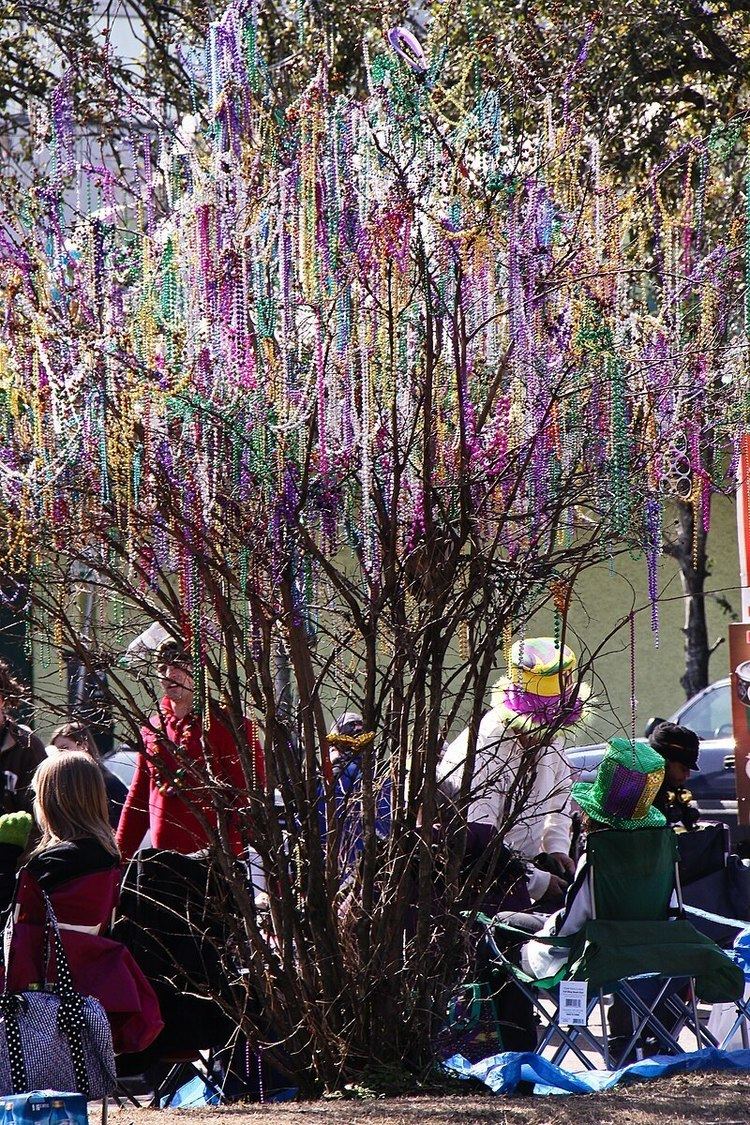 | ||
When the parade season ended in 2014, the New Orleans city government spent $1.5 million to pick up about 1,500 tons of Mardi Gras-induced waste, consisting mostly of beads. This is a recurring problem every year for the city. In addition, the city must also deal with the environmental repercussions endured after Mardi Gras. Because they are not biodegradable and contain high amounts of heavy metals, Mardi Gras beads put the local environment and health of southern Louisianians at risk.
Contents
Bead composition
Polyethylene and polystyrene are popular plastics used in beads. Polystyrene is very stable and can last for many decades as the beads lay in landfills. Eventually, it will begin to slowly oxidize via UV light from the sun. In contrast, polystyrene cannot decompose with UV radiation and biodegrades extremely slowly.
Lead, cadmium, and other elements have been detected in beads in extremely high amounts through various analytical techniques. Many of these elements exceed the suggested safety limits set by the Consumer Product Safety Commission. For example, the safe amount of lead in a product is 100 ppm; however, there have been findings where the amount of lead in a bead surpassed the limit 300 times over. This threatens parade-goers with exposure to high amounts of lead, especially younger children that could potentially put the beads in their mouths.
Entry into the environment
Beads can accidentally enter storm drains, which empty into Lake Pontchartrain and the Mississippi River, which drains into the Gulf of Mexico. The metals in the beads put fish and other marine lifeforms at risk for lead and cadmium poisoning. Exposure to these metals in water causes high mortality rates and increased biomass of these metals among fish species within a month of exposure. Seafood is prevalent in the south Louisiana diet, most of which is harvested from the Gulf. Eating seafood contaminated with lead and cadmium puts people at risk for poisoning.
Beads also can get tangled in trees during parades. Here, the lead in the beads can get washed off via rain water and find its way into leaves and soil. Lead has been shown to be an inhibitor of cell division, water uptake, and photosynthesis, eventually causing death to the plant.
Impact on humans
Lead exposure has been evidenced to significantly inhibit neurological function. One study examined identical twins who worked together as painters using lead-based paint. Using magnetic resonance spectroscopy, it was discovered that they both had lead levels in their bones about 5-10 times more than the average adult. One twin put himself at a higher risk of lead exposure because he was the only one that removed paint on the job. His lead concentration was 2.5 times higher than his twin’s; and after further testing, his memory was shown to be much worse than his twin’s.
Cadmium has been shown to be carcinogenic due to interactions with DNA topoisomerase IIα. This enzyme helps facilitate cell division and DNA repair, specifically with double strand breaks. Cadmium cations react with the topoisomerase in the following manner:
8 Cd2+ + topoisomerase IIα – 8H --> topoisomerase IIα – 8 Cd2+
Here, the cadmium ions react with sulfur-containing thiol groups in cysteine residues, effectively ruining the structure and function of the topoisomerase.
Solutions
Mardi Gras will unlikely be cancelled due to its cultural and economic importance, but a concerted effort can still be made to curb the negative environmental effects of the beads. One suggested avenue is to replace currently used plastics with polylactic acid (PLA), an environmentally much more friendly material. This polymer can be degraded naturally into lactic acid via hydrolysis or self-hydrolysis, which decomposes whole PLA products in as quickly as a month. A second way is to “recycle” by purchasing used beads rather than buying new ones, which can also save krewe members money.
